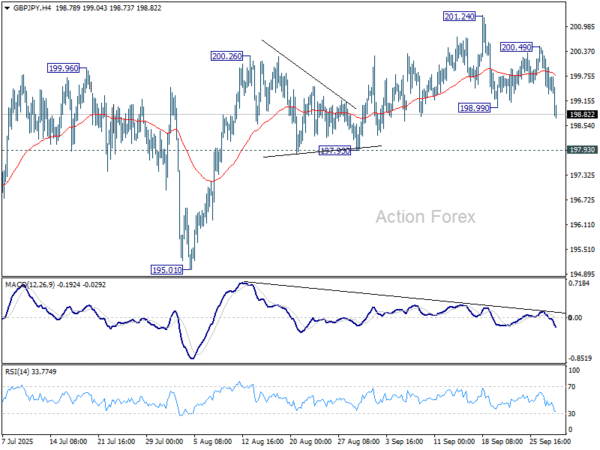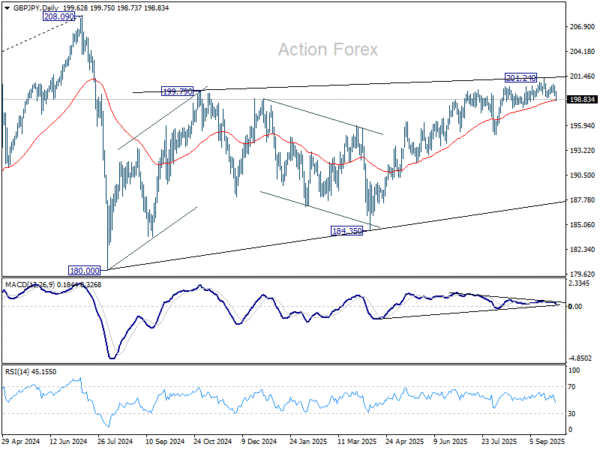Markets Cautious at Quarter-End, Aussie and Yen Lead FX – Action Forex
Australian Dollar is staying the day’s top performer, rallying after the RBA kept its cash rate unchanged but leaned hawkish in tone. Later at the press conference, Governor Michele Bullock avoided any firm guidance on future cuts, telling reporters she would not “predict what the interest rate is going to be in the next three to six months.”
Bullock emphasized that the current backdrop is “quite a positive situation,” pointing to inflation within the 2–3% target band and employment hovering around full employment. While monthly CPI has been volatile, she reiterated that the RBA continues to focus on the quarterly trimmed mean as its preferred measure of inflation. Her comments reinforced market expectations that November is a live meeting and that a cut is far from certain.
Meanwhile, Yen also strengthened broadly, supported by a cautious risk tone as the US edges closer to a partial government shutdown. At the same time, speculation is intensifying that the BoJ is preparing to hike rates in Q4. December appears the more likely timing, but October cannot be ruled out given the central bank’s track record of surprising markets. Importantly, the October meeting will include new economic projections that could provide the justification for an earlier move.
Some traders may already be positioning for a hawkish shift, particularly as BoJ officials have turned more vocal about the risks of sustained inflation. The Tankan survey and further guidance from policymakers will be critical in shaping expectations.
By performance, the Aussie leads FX, followed by Yen and Kiwi. Loonie lags at the bottom alongside Dollar and Swiss Franc, while Euro and Sterling are trading mid-pack.
In Europe, at the time of writing, FTSE is up 0.16%. DAX is up 0.13%. CAC is down -0.26%. UK 10-year yield is up 0.004 at 4.709. Germany 10-year yield is up 0.009 at 2.721. Earlier in Asia, Nikkei fell -0.25%. Hong Kong HSI rose 0.87%. China Shanghai SSE rose 0.52%. Singapore Strait Times rose 0.71%. Japan 10-year JGB yield rose 0.004 to 1.651.
Fed’s Jefferson sees labor market vulnerable if unsupported
Fed Vice Chair Philip Jefferson said in a speech today while tariffs have added to price pressures, the impact has been “lower than what many forecasters predicted” this spring. Encouragingly, short-term expectations have eased from Q2 highs, while long-term expectations remain anchored. As a result, he expects the disinflation process to “resume after this year” and inflation to eventually return to the Fed’s 2% target “in the coming years”.
On the labor side, Jefferson highlighted softening conditions. He warned that the job market could “experience stress” if left unsupported, and said this was a key reason he backed a 25bp rate cut at the last FOMC meeting.
Looking ahead, Jefferson stressed that policy will remain data-dependent, with the Fed monitoring both economic indicators and government policies.
Swiss KOF barometer rises to 98.0, outlook still subdued
Switzerland’s KOF Economic Barometer rose to 98.0 in September from 96.2, beating expectations of 97.3. The improvement marks a rebound after last month’s dip, though the indicator still lingers below its long-term average, underscoring a “subdued” outlook.
According to KOF, the uptick was driven by stronger signals from manufacturing as well as financial and insurance services. These production-side sectors showed notable improvement, suggesting some resilience in key parts of the economy.
However, demand-side indicators were less encouraging. Foreign demand weakened, while the outlook for private consumption remained unchanged.
RBA holds steady at 3.60%, warns Q3 inflation may surprise on upside
The RBA left its cash rate unchanged at 3.60% in a unanimous decision, in line with expectations. The move reflects the Board’s preference to pause while monitoring whether recent economic surprises point to a more persistent inflation challenge.
According to the RBA, recent partial data suggest that September-quarter inflation may come in above projections made in August. At the same time, labor market indicators show conditions have been steady and remain “a little tight”, reinforcing the risk that price pressures may not ease as quickly as anticipated.
The Bank outlined two contrasting scenarios for household demand. Stronger consumption may reflect rising real incomes and wealth, potentially allowing firms to raise prices more easily and encouraging further hiring. Alternatively, this consumption rebound may not last if households turn more cautious amid uncertainty around overseas developments.
BoJ summary reveals rising hawkish pressure, but board still divided
The BoJ’s September Summary of Opinions revealed that members debated the feasibility of raising interest rates in the near term, with some arguing that conditions were aligning for another move. The release underscores a growing hawkish tilt inside the Board, even as the majority voted to hold steady at 0.50%.
One member argued that “judging solely from the perspective of Japan’s economic conditions, it may be time to consider raising the policy interest rate again,” noting that more than six months have passed since the last hike. Another highlighted easing concerns from U.S. tariffs, suggesting external impact on inflation had “abated” and that the BoJ could “return to its stance to raise the policy interest rate.”
At the same time, caution was evident. Some warned against surprising markets with a hike, stressing that Japan’s domestic demand remains vulnerable to external shocks. The view was that it would be better to wait for more hard data before making another adjustment.
At the September 18–19 meeting, the BoJ left rates at 0.50%, though two members dissented in favor of a hike to 0.75%.
Japan’s industrial output falls -1.2% mom in August, retail sales contracts
Japan’s latest data painted a downbeat picture of economic momentum in August. Industrial production slipped -1.2% mom, falling short of the expected -0.8%. Of the 15 industrial sectors, 12 including metal products, and inorganic and organic chemicals, saw output decreases.
METI maintained its description of output as “fluctuates indecisively”. Officials stressed that firms remain highly cautious in their production planning. Still, manufacturers surveyed see output rising 4.1% in September and another 1.2% in October.
Household demand faltered at the same time, with retail sales tumbling -1.1% yoy, marking the first decline in 42 months.
China’s NBS PMI points to easing manufacturing weakness, services soft patch
China’s official PMI data for September signaled tentative improvement in industry but lingering softness in services. The NBS Manufacturing PMI rose to 49.8 from 49.4, its highest since March, though it still pointed to contraction. The gauge has been under 50 since April, reflecting headwinds for large and state-linked producers.
The NBS Non-Manufacturing PMI slipped from 50.3 to 50.0, effectively flatlining and pointing to a loss of momentum in construction and services. That stagnation raises questions about the strength of domestic demand, even as authorities step up stimulus efforts.
In contrast, the RatingDog (S&P Global) surveys offered a more optimistic take. Manufacturing improved to 51.2 from 50.5, the strongest since May, suggesting that private and export-focused companies are benefiting from external demand. Services edged down slightly from 53.0 to 52.9 but remained firmly in growth territory.
NZ ANZ business confidence ticks down, but activity outlook improves
New Zealand’s ANZ Business Confidence edged slightly lower in September, slipping from 49.7 to 49.6. Though, Own Activity Outlook improved to 43.4 from 38.7.
Inflation pressures ticked mildly higher. One-year-ahead inflation expectations rose to 2.71% from 2.63%,. The share of firms expecting to raise prices in the next three months climbed to 46%. Cost expectations also edged up, with 75% of respondents seeing higher input costs.
ANZ noted that the RBNZ is positioned to support growth with a lower Official Cash Rate. While the exact path of policy easing remains uncertain, the bank said the OCR will ultimately reach the level required to ensure the recovery takes hold.
GBP/JPY Mid-Day Outlook
Daily Pivots: (S1) 199.10; (P) 199.82; (R1) 200.30; More…
Intraday bias in GBP/JPY is back on the downside with break of 198.99. A short term top should be formed at 201.24, on bearish divergence condition in 4H MACD. Deeper fall should be seen to 197.93 support first. Firm break there will argue that whole rise from 184.35 has completed too and target 195.01 support next. For now, risk will stay on the downside as long as 200.49 support holds, in case of recovery.
In the bigger picture, price actions from 208.09 (2024 high) are seen as a correction to rally from 123.94 (2020 low). The pattern might still extend with another falling leg. But in that case, strong support should be seen from 38.2% retracement of 123.94 to 208.09 at 175.94 to contain downside. Meanwhile, decisive break of 208.09 will confirm long term up trend resumption.


